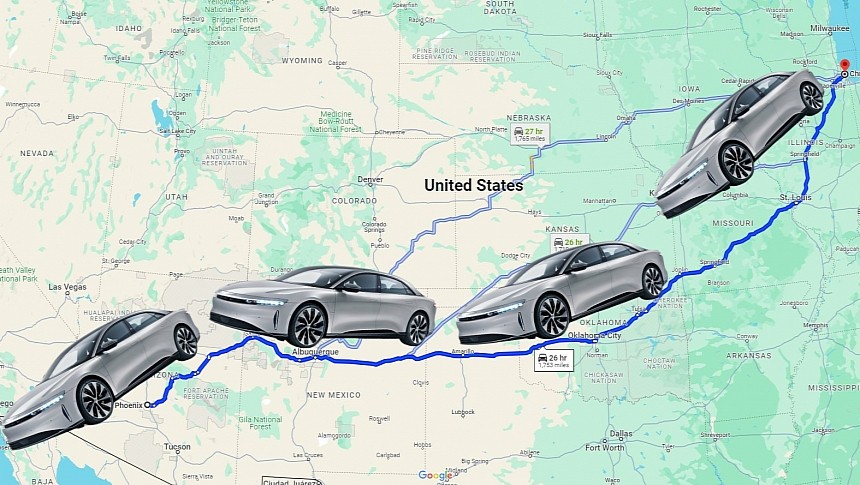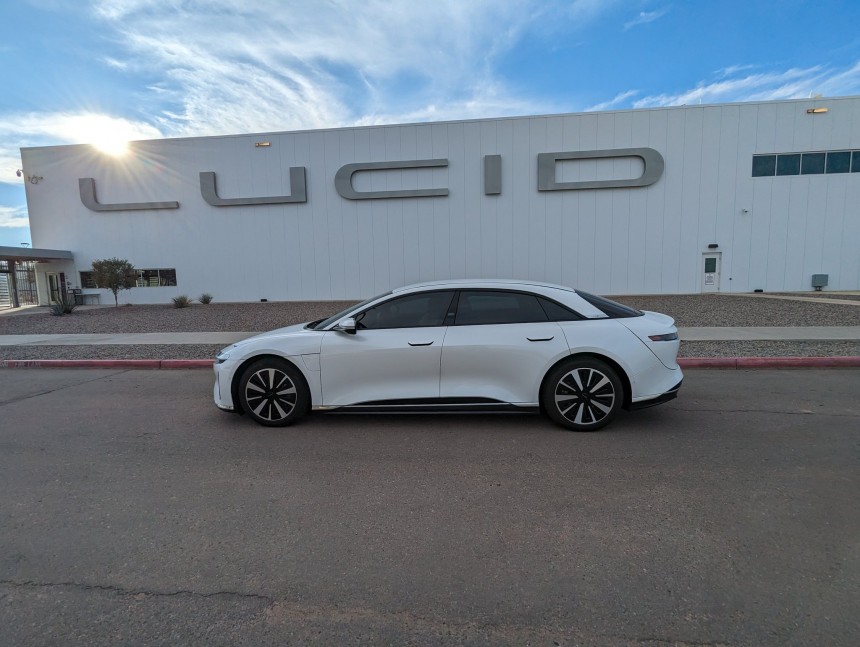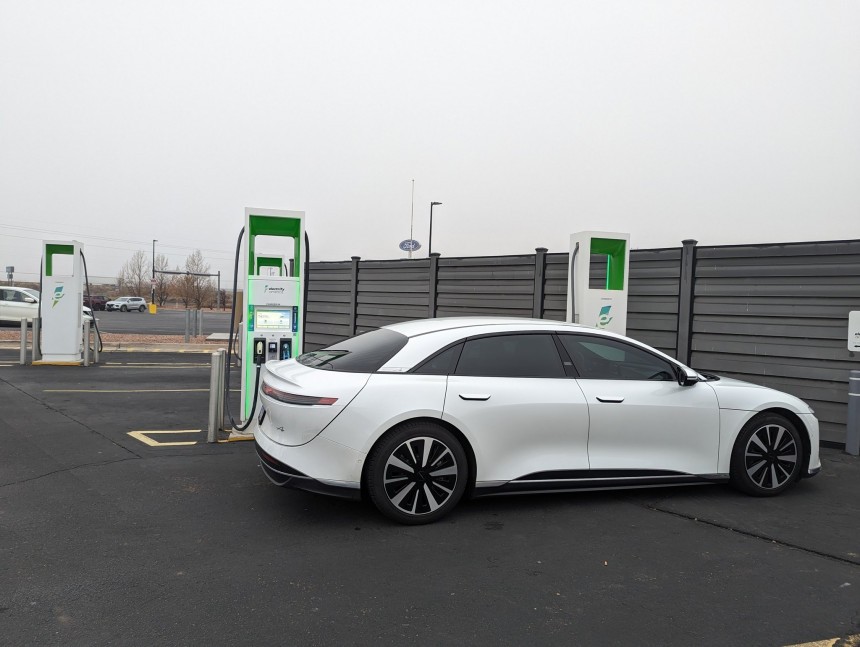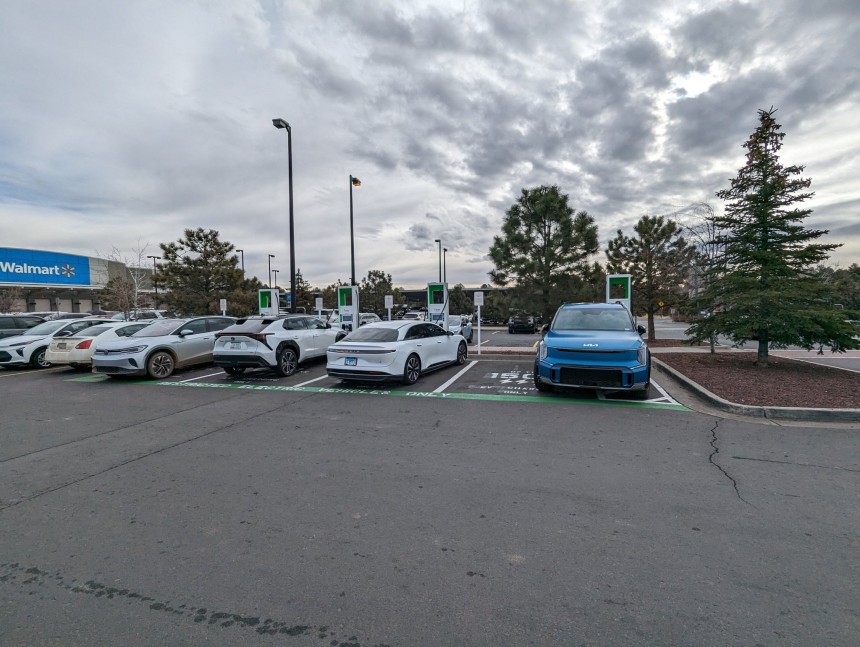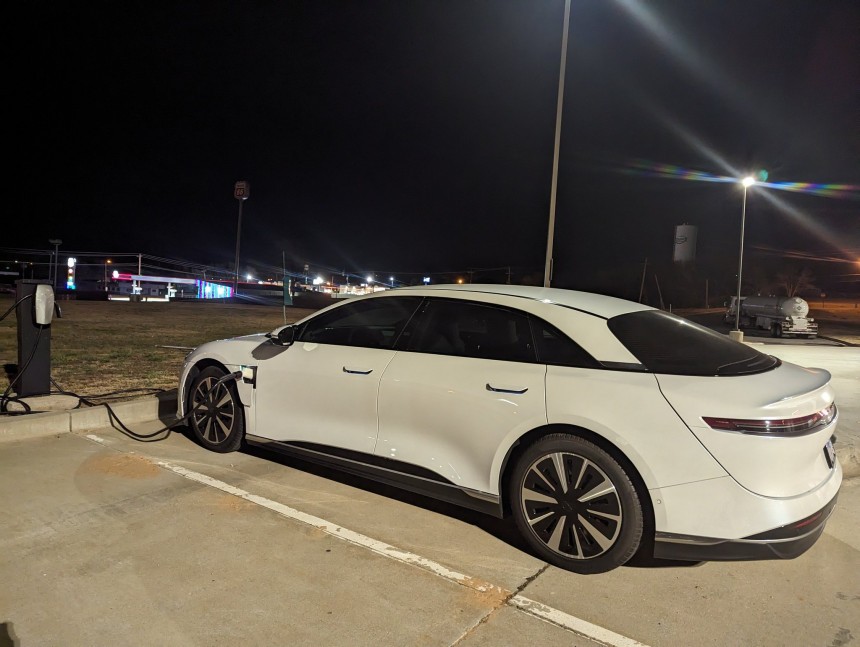Tesla's Model Y – an all-electric crossover SUV – became 2023's world's best-selling vehicle. It was an important premiere. For the first time, most new car buyers chose an EV as their next ride. That's a great sign for manufacturers that poured billions into ditching fossil fuel-powered drivetrains. It's also a warning for brands lagging behind the curve. However, the transition might be a little more complicated for the average buyer. Here's what this guy discovered after taking his Lucid on a 1,800-mile journey.
Before we dive in, please keep in mind that this piece is not meant to sway you away from purchasing an EV. We're only trying to help you gain a better understanding of how things really are. Once the green promises and the novelty are out of the picture, it's your job to handle gas-free personal mobility. It could work out in your favor! Now, let's jump in.
It's no secret: good cars are expensive. That's the case for EVs, too. This guy bought a dual-motor Lucid Air Pure with 19-inch wheels. The posh sedan has an MSRP of $82,400 before diving into the realm of optional equipment. Given that it's not an SUV, it's also not eligible for the updated EV tax credit. Thus, you're looking at a rather hefty purchase cost.
But let's say you can swing it. This person did it, and he decided to put the sedan's road-tripping qualities to the test. If you're unfamiliar with the Lucid Air, imagine it as the American-designed and -made Mercedes-Benz EQS that looks like a normal vehicle and not a very aerodynamically efficient blob with less impressive cabin tech. The Air's underpinnings are impressive, though!
According to the Environmental Protection Agency (EPA), his Lucid should be capable of doing 410 miles on a single charge with an average efficiency of 24 kWh per 100 miles (161 kilometers) or 4.1 miles (6.5 kilometers) per kWh. These are just reference figures. Actual results will vary depending on driving style, weather, payload, and battery degradation.
On his journey from Chicago, Illinois, to Phoenix, Arizona, he exclusively used Electrify America's DC fast chargers. That's because Lucid struck a deal with the Dieselgate-born, VW-owned high-power charging network to give Air Pure buyers one year of free charging as long as they don't go beyond the "reasonable personal use" limit. Originally, the automaker offered three years of complimentary charging.
The man stopped to replenish the sedan's high-voltage energy storage unit 15 times along the way. That may seem outrageous at first, but he approached the situation smartly. The EV only received the amount of electrons needed to arrive at the next charger and nothing else. He spent between 17 and 60 minutes at a stall.
Charging to 100% at a Tesla Supercharger-like stall is not recommended because almost all EVs throttle the charging speed above 80%. If going from 10 to 80% state of charge takes an hour, fully charging from 80 to 100% might take almost two hours. It's just not efficient. Hopping from station to station is much better.
He could have finished the whole trip faster, but some chargers didn't work at their full capacity. That hindered the EV's capacity to suck electrons from the grid at a high rate. The Lucid, even in this entry-level spec, is capable of charging rather fast. Thus, the car can't be blamed here.
Still, he had to face very optimistic charging estimates. The EV's trip planner anticipated about four and a half hours of time spent plugged in. In reality, he had to keep the Air hooked to a dispenser for almost eight hours to complete the 1,800-mile adventure. While he avoided looking for another charging station and possibly paying for electricity, he couldn't escape the problematic dispensers that didn't work as advertised. He even underlined that the 150-kW chargers often worked better than the 350-kW ones that were supposed to be more than twice as good.
The trip took three days, but he stopped at a hotel where he plugged in and charged the EV to 100% overnight. The weather was also friendly, with temperatures ranging between 50 and 60 degrees Fahrenheit (10 and 16 degrees Celsius).
Were he to pay for all the fast charging, the man would have spent almost $355. The national (including California) average gas price is $3.1 when writing. That sum buys you 114.5 gallons of fuel. A rear-wheel-drive 2023 BMW X3 has an EPA-rated combined fuel economy of 25 mpg.
That amounts to a maximum range of about 2,863 miles – over 1,000 more than what the EV delivered for the same money. Filling up also takes only a couple of minutes and it's a hassle-free process. Just pay, use the pump, and go.
The Air Pure owner also admitted in a private Facebook group that this kind of trip usually takes him two and not three days, as it happened with the zero-emission sedan.
Thus, the main advantage of EVs remains that they are zero-emission. Road transport is a major contributor to global warming because of the greenhouse gas emissions released into the atmosphere. But when it comes to traveling long distances, you would be better off with a hybrid or, as was the case here, an EV that comes with a free fast-charging plan attached.
But despite all the above, I can't say in good faith that you should give up on buying or leasing an EV just because fast charging is costly and may take more time than filling up with gas.
If you're in need of a commuting appliance and have a home or access to a domestic socket where you currently live, something like a Tesla Model 3, a Hyundai Kona Electric, or a VW ID.4 makes a ton of sense. It's cheaper and more convenient to charge overnight at home or for a couple of hours at the office than to visit a fuel station every once in a while.
Whatever you choose as your next ride, just make sure it suits your mobility needs. Good luck!
It's no secret: good cars are expensive. That's the case for EVs, too. This guy bought a dual-motor Lucid Air Pure with 19-inch wheels. The posh sedan has an MSRP of $82,400 before diving into the realm of optional equipment. Given that it's not an SUV, it's also not eligible for the updated EV tax credit. Thus, you're looking at a rather hefty purchase cost.
But let's say you can swing it. This person did it, and he decided to put the sedan's road-tripping qualities to the test. If you're unfamiliar with the Lucid Air, imagine it as the American-designed and -made Mercedes-Benz EQS that looks like a normal vehicle and not a very aerodynamically efficient blob with less impressive cabin tech. The Air's underpinnings are impressive, though!
According to the Environmental Protection Agency (EPA), his Lucid should be capable of doing 410 miles on a single charge with an average efficiency of 24 kWh per 100 miles (161 kilometers) or 4.1 miles (6.5 kilometers) per kWh. These are just reference figures. Actual results will vary depending on driving style, weather, payload, and battery degradation.
The real-world experience
The Lucid Air owner is no stranger to an all-electric lifestyle. He previously owned a Chevrolet Spark EV (which GM abandoned completely by not offering high-voltage battery replacements) and is also fond of casual racing.On his journey from Chicago, Illinois, to Phoenix, Arizona, he exclusively used Electrify America's DC fast chargers. That's because Lucid struck a deal with the Dieselgate-born, VW-owned high-power charging network to give Air Pure buyers one year of free charging as long as they don't go beyond the "reasonable personal use" limit. Originally, the automaker offered three years of complimentary charging.
The man stopped to replenish the sedan's high-voltage energy storage unit 15 times along the way. That may seem outrageous at first, but he approached the situation smartly. The EV only received the amount of electrons needed to arrive at the next charger and nothing else. He spent between 17 and 60 minutes at a stall.
Charging to 100% at a Tesla Supercharger-like stall is not recommended because almost all EVs throttle the charging speed above 80%. If going from 10 to 80% state of charge takes an hour, fully charging from 80 to 100% might take almost two hours. It's just not efficient. Hopping from station to station is much better.
There's a silver lining
The most impressive thing? He only had to move once to another dispenser on the way to Phoenix. Electrify America delivered! He wasn't forced to complicate his travel plans because of the energy provider. That's a plus, considering the network's reputation among seasoned EV owners.Still, he had to face very optimistic charging estimates. The EV's trip planner anticipated about four and a half hours of time spent plugged in. In reality, he had to keep the Air hooked to a dispenser for almost eight hours to complete the 1,800-mile adventure. While he avoided looking for another charging station and possibly paying for electricity, he couldn't escape the problematic dispensers that didn't work as advertised. He even underlined that the 150-kW chargers often worked better than the 350-kW ones that were supposed to be more than twice as good.
The trip took three days, but he stopped at a hotel where he plugged in and charged the EV to 100% overnight. The weather was also friendly, with temperatures ranging between 50 and 60 degrees Fahrenheit (10 and 16 degrees Celsius).
That amounts to a maximum range of about 2,863 miles – over 1,000 more than what the EV delivered for the same money. Filling up also takes only a couple of minutes and it's a hassle-free process. Just pay, use the pump, and go.
The Air Pure owner also admitted in a private Facebook group that this kind of trip usually takes him two and not three days, as it happened with the zero-emission sedan.
A few pros, a couple of cons, and a ton of opportunities
Other EV-curious people or owners of similar rides agreed that road-tripping with the Lucid would stop making sense when the free charging plan is gone.But despite all the above, I can't say in good faith that you should give up on buying or leasing an EV just because fast charging is costly and may take more time than filling up with gas.
If you're in need of a commuting appliance and have a home or access to a domestic socket where you currently live, something like a Tesla Model 3, a Hyundai Kona Electric, or a VW ID.4 makes a ton of sense. It's cheaper and more convenient to charge overnight at home or for a couple of hours at the office than to visit a fuel station every once in a while.
Whatever you choose as your next ride, just make sure it suits your mobility needs. Good luck!
